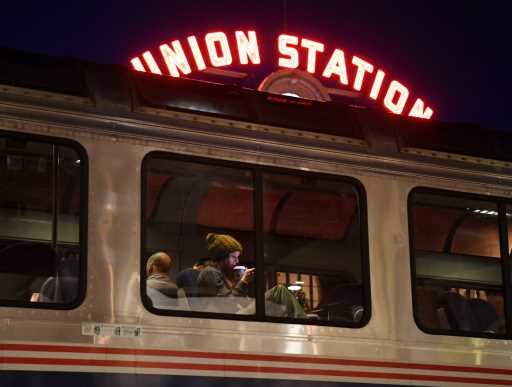The burgeoning Front Range corridor is “long past ready” for a regional passenger rail line, Amtrak’s top executives said Monday, the latest sign of growing momentum for a multibillion-dollar project that could take a decade or longer to build.
The Amtrak officials provided new details on how a state-federal partnership might pay for and operate the line along the Interstate 25 corridor. Eventually, the railway could stretch nearly 300 miles from Cheyenne, Wyoming, south to Pueblo or Trinidad.
The full build-out has been estimated to cost as much as $14 billion, but a recent state report said initial service might be possible for as little as $2 billion.
“We really think that this corridor is ready — it’s long past ready,” Amtrak President Stephen Gardner said during a call Monday morning with some members of Colorado’s Front Range rail commission and Amtrak CEO Bill Flynn. “We need to move forward with investments here, and Amtrak is excited to partner to make that happen.”
Colorado lawmakers, seeking to seize on the potential for federal funding, introduced bipartisan legislation Friday that would establish the Front Range Passenger Rail District. Covering all or part of 13 counties, the new district would build and oversee the system. It also could ask voters in coming years for a new sales tax of up to 0.8 percent to raise money.
Though the bill doesn’t specify who would operate the line, members of the Front Range rail commission, which has been exploring the line’s viability, said Amtrak would make the most sense. That’s in part because federal law gives Amtrak the right to use freight-rail tracks, potentially simplifying the initial route.
Amtrak is better known for its multi-state routes, including the California Zephyr and the Southwest Chief that pass through Colorado. But the agency said shorter state-supported regional lines accounted for half of its passenger traffic prior to the pandemic.
Its executives envision a similar role for Amtrak in a Front Range line, which would traverse a corridor that’s home to more than 80% of the state’s population. The state could provide oversight and some funding while Amtrak potentially uses its trains and employees to run it. But those details would be subject to negotiation.
Laying the groundwork
Colorado Senate President Leroy Garcia, a Democrat from Pueblo, long has championed Front Range rail and hoped to float the bill to create the rail district last year, but the pandemic interfered. He has a raft of co-sponsors from up and down the corridor, including Republicans Kevin Priola of Henderson and Cleave Simpson of Alamosa.
This year, Garcia said, the timing seems even better.
“Knowing right now that not only are cities and communities across the state interested in this, but that from the federal level there could be this massive infusion of money to help bring this to reality, that’s really important,” he said in an interview.
The greatest recent promise for federal help lies in President Joe Biden’s proposed $2.3 trillion plan to tackle infrastructure and other needs. The plan, which still faces intense scrutiny from Congress, pitches $80 billion to fortify and expand Amtrak’s network across the country.
The national passenger railway has sought boosts through other avenues in Congress, too, including an unsuccessful surface-transportation bill last year. Amtrak said at the time that the Front Range line could be prioritized for as much as $2 billion. On Monday, Gardner said Amtrak would soon summarize its “core requests” as part of the Biden proposal.
Pinning down federal and state contributions will require more intensive talks with officials in Colorado and Wyoming, he said.
“The examples are there” showing that regional rail lines can attract riders and reduce highway traffic, Amtrak CEO Flynn said, citing its routes in Washington state, North Carolina and between Chicago and Milwaukee. “We believe we’ve got the right partnership with Colorado and, ultimately, with Wyoming, to build that out.”
Routing and cost not yet figured out
Still, don’t count on a Front Range rail line happening yet. There’s a lot to be worked out: the cost, how to pay for it, a decision to use conventional or high-speed rail and an exact route.
Options in the commission’s recent Alternatives Evaluation Report vary the most through metro Denver and northern Colorado, with one going through Boulder and Longmont — similar to the Regional Transportation District’s unfunded northwest rail extension. Another would run closer to I-25 and a third would loop east around E-470, instead of connecting near Union Station, to provide a connection to Denver International Airport.
The cost estimates laid out in the report range from $7.8 billion to $14.2 billion. That’s for a line running entirely along dedicated double-track from Pueblo to Fort Collins in a final configuration, with travel times ranging from 149 to 169 minutes depending on the route. Ridership projections vary from 4,800 a day for the north I-25 route to 6,900 a day for the route that includes Boulder, with the airport route estimated to attract slightly fewer.
“In theory, we could start to see some service in a decade but … this isn’t something that happens overnight,” said Sal Pace, a former state legislator from Pueblo who is the commission’s vice chair. “But it’s something where we can get the ball rolling pretty quickly.”
Amtrak’s Gardner is more optimistic that an initial line could happen sooner by using temporary configurations on existing freight track, though Amtrak would need to work out agreements with the railroads.
The commission’s report says “a much smaller investment, in the $2 billion to $6 billion range,” could accomplish a shorter-term plan aimed at building initial ridership. Initial segments would most likely run north and south from metro Denver, observers say.
Source: Read Full Article

